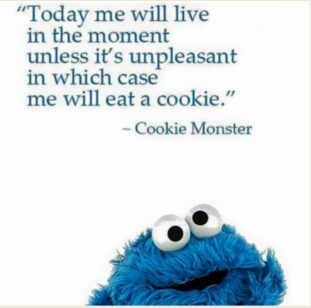We’ve all been there. It’s been a crappy day. Maybe you’re fighting with your significant other, your kids are driving you up the wall, or you got an e-mail from the boss you’d been dreading. How do you deal? Well, in a perfect world you would hit up the gym and absolutely annihilate a workout. Unfortunately the world we live in is far from perfect and many individuals opt instead to drop by the DQ drive-thru for a large Reese’s blizzard. Or perhaps ordering and subsequently eating a whole pizza sounds like the perfect therapy to get over that bad day? Emotional eating can be a real beast to deal with, and frequently we don’t realize we’re falling into this result-destroying habit until it’s too late.
Very few and far between are the individuals who are immune to emotional eating. Personally, it’s something I’ve fought through on more than an occasional basis, and still fall victim to at times. Those who haven’t truly experienced emotional eating will often recommend “Oh, you just need to exercise some more self control!” or chalk it up to your own personal “lack of discipline” Truth be told, emotional eating is far more complex than lacking self-control, and the issue is far from binary, not something that can just be switched “on” or “off” Today, we are going to explore some of the causes of emotional eating, as well as
Finding the Root
Major life events or stressors can cause emotional eating, but more frequently it’s just the little day-to-day BS that results in reaching for junk food in large quantities. Relationship conflicts, work troubles, and checking your bank account after the weekend can often be cause for alarm or feeling stress. What’s more comforting than food, right? Foods have the capacity to make us feel REALLY GOOD! Hell, when we see food we know we love (like Grandma’s pie on Thanksgiving), the brain releases chemicals similar to those found in cocaine and heroin. So yes, food addiction and emotional eating can in fact be another form of “substance abuse”
What’s your trigger? One method championed by many mental health professionals is to keep an actual, legitimate “food diary” – not only documenting what you eat, but how you feel prior to and after eating, as well as when and how much you’re consuming. Details like this can help with determining patterns of emotional eating. More simply, asking yourself questions “Am I actually hungry right now?” or “Why do I want this?” when you’re reaching for comfort food, work well for self-analysis – if you’re feeling stressed, bored, angry, or generally unhappy, you can work to work to correct the habit!
Food as Pleasure
As we just discussed, food can be extremely pleasurable, especially as a response to stress – we feel terrible, and food is there to make us “feel better” Typically, once that initial “rush” has passed, we feel a sense of guilt (which, ironically enough, often leads to more emotional eating). Some individuals look forward to nothing more than cracking open a new container of ice cream, or a bag of chips, as a way to unwind at the end of the day – this can be relaxing and calming. What’s the solution then? Find a new source of pleasure, or at the very least, a positive “distraction” – something else to do. No, it’s not going to replace food or make you feel near as good as food does, to go on a walk first thing when you get home, or to phone a friend each time you feel the urge to reach for the cheesy popcorn. Just know that you are making positive changes which will ultimately lead to better health and break the negative behaviors you’ve built! Creating a plan for dealing with the temptation of emotional eating when it arises, will keep you a step ahead of the game!
Also worth mentioning here is breaking the “food as a reward” cycle. If you’re changing your lifestyle from unhealthy to healthy, food should be viewed as fuel for the machine you’re building (your body). Different celebratory events like office parties or work holidays typically bring in items like pizza, ice cream, cakes, and so on. These are habits worth breaking. I’m not saying you shouldn’t enjoy yourself, but these situations are absolutely perfect for sabotaging your own hard-earned progress with empty calories.
Lead Me Not to Temptation…
One thing I frequently say to clients and prospects alike is “If you don’t have it in your house, guess what? You can’t eat it” Keeping unhealthy foods out of your fridge and pantry, while also not allowing them inside your house, makes it that much more difficult to reach for them when you’re feeling an emotionally-linked craving coming on. If you’re having a crappy day at work, hitting the drive thru for your favorite cheeseburger with fries and a large chocolate shake might seem like a great idea, but going for a walk is more productive on all fronts – not only will you come back with a clearer head, but you’ll have expended calories rather than consuming them.
Acceptance

Learning how to accept feelings -both positive and negative- is a difficult process, but is absolutely pivotal if you’re going to master and defeat emotional eating habits. Staying “emotionally available” and open to “getting comfortable being uncomfortable” is crucial. What I mean here, is becoming more mindful and in-tune with our day-to-day and moment-to-moment emotional experience is a turning point for emotional eating habits. Once we are able to slow things down, readily accept and acknowledge negative event/stressors, we are able to formulate solutions to them which don’t involve eating our feelings! The next time you experience something negative (a trigger for what would otherwise become emotional eating), take a step back, realize exactly what it is that is causing you to feel this way, and find another solution! Easier said than done, right? With practice, this comfort in your own emotions will be your gateway to mastery of emotional eating!
Be Aware
Sometimes, eating can be totally mindless or unconscious – this is especially common at large events with lots of food, as well as at buffets and around the holidays. However, unconscious eating can also occur when we are sitting in front of the TV, the computer, or working on some other semi-distracted task. One moment you sit down at the computer to finish a project for work, the next you’ve downed half of a 32oz container of mixed nuts. While not necessarily “emotional” eating, this type of gorging oneself is something that should be checked and corrected. Stick to pre-portioning things at their recommended serving sizes – for example, while it’s really easy to mindlessly chow down half a bag of chips, a typical serving size is usually 20-30 chips. Another totally simple yet surprisingly effective rule here is to eat ONLY while sitting down at your dining room table, stay out of the living room, office, etc.
It’s OK to Fall Off
No matter where you are on the spectrum of emotional eating, from the occasional splurge to the full blown addict – know that weaning yourself away from these habits is a process. Backsliding can and will occur, and that’s okay. The important thing is to learn from your mistakes, not to chalk them up as failures, but rather learning experiences. If and when you do “fall off” or have an episode of emotional eating, recognize it. Take a step back, look at it from the outside using the tips described above – what caused it, what could have been done to prevent it, how did you feel before and afterwards, and so on. Come up with a plan to deal better next time! If everything is a learning mistake, not a failure, you can set yourself up for success in the future. There will be opportunities to “cheat” along the way, foresee them and put yourself in the driver’s seat. Let’s look at the upcoming week – you have a social event coming up on Thursday where you know there will be plenty of food which is not conducive to your goal. Here, you’re faced with a decision, you can use this event as a “cheat” (though I dislike that word in the dietary context…semantics) to keep yourself sane – or, an exercise in building enhanced discipline, by restraining yourself. This doesn’t mean you can’t enjoy yourself, but instead you have the opportunity to go in with a PLAN – you more than likely have a rough idea of what’s going to be there, go in knowing what you’re going to eat, and in what quantities (try to limit yourself to two plates max, with a small serving of dessert – this is the guideline I follow). There are no accidents when it comes to nutrition. If you go into each situation with a plan of attack, you will come out successful, happy, and guilt-free!
Call for Help
Surrounding yourself with those on the same mission, or at least those who genuinely support you and have empathy, is absolutely critical to success. These are positive support systems. Reach out to a friend, a family member, or a professional if need be. Recognize and be wary of negative support systems as well – these can often be “wolves in sheep’s clothing” – individuals that you’d like to think would be supportive of your mission of self-betterment, but are actually against you, or worse – indifferent. Rid yourself of these negative influences.
Wrap-Up
Look, emotional eating is quite the animal. There’s absolutely no doubt about that. With acceptance, diligence, and practice, emotional eating is completely beatable and reversible. It will take some time, and a good amount of effort, but breaking these habits will bring you through to the other side a healthier and happier person. Food isn’t something to be viewed in a negative or obsessive light; it is there as fuel and sustenance first, and our enjoyment is secondary. Reaching a healthy mindset when it comes to the choices you make regarding your nutrition will help you enjoy the best of both worlds!
